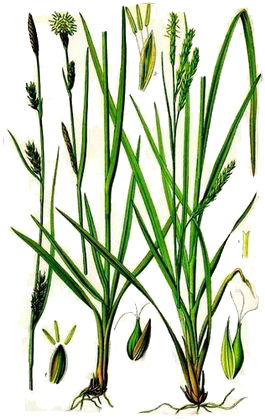Sedge parvskaya – Carex brevicollis D С.
Perennial plant up to 40-50 cm, families osokovыh (Swreraseae). Medicinal raw materials are leaves of sedges, of which produced the drug "Brevikollina hydrochloride".

Sedge parvskaya – Chemical structure
The above-ground part of the plant, especially the leaves contain alkaloids brevikollin, brevikarin, hormones, and other plant compounds.
Sedge parvskaya – Pharmacological properties
High biological activity sedge parvskoy determined by the content therein alkaloid brevikollina, which, blocking the conduction of impulses in the autonomous units, provides pharmacological denervation of, t. it is. brevikollin, without acting directly on the executive bodies, alters their function, reducing the flow of nerve impulses to them by sympathetic and parasympathetic nerves.
Brevikollin dilates blood vessels, especially arterioles, bringing the arterial and central venous pressure decreases. Due to the mesenteric blood supply advanced vessels and vessels of the lower extremities is reduced pressure in the pulmonary circulation, that reduces cardiac output, what is happening under the influence of the alkaloid plants. Reducing the cardiac output, as well as decrease peripheral vascular resistance, reduces the load on the left ventricle, but the oxygen supply of tissue is not disturbed.
The blockade of parasympathetic sites, through which the innervation of the bronchial smooth muscle and gastrointestinal tract, brevikollina accompanied by the action of the expansion of smooth muscle. In experiments on laboratory animals have very small doses brevikollin enhances the contractile function of smooth muscle of the uterus and improves skin tone, without significant effect at these doses on other systems and organs. According to the characterization of acute toxicity brevikollin approaching the level of toxicity pahikarpin.
Sedge parvskaya – Use in medicine
The native form sedge parvskaya for medicinal purposes does not apply, but it serves as a raw material for brevikollina hydrochloride. The most important is brevikollin in obstetric practice, it is used in the weakness of labor, with early discharge of amniotic fluid, with uterine bleeding after abortion and postpartum bleeding, associated with uterine subinvolution. Besides, alkaloid plant is sometimes used to treat hypertension, left ventricular failure, asthma and obliterating endarteritis.
Brevikollina hydrochloride is not recommended for use inside for gastritis, gastric ulcer and duodenal ulcer,due to the pronounced irritant action.
When using brevikollina hydrochloride may experience side effects: noise in ears, impaired hearing, feeling stunned, headache, dry mouth, ccomodation, decrease intestinal peristalsis. Because of the blockade of sympathetic ganglia and violations of reflex mechanisms to ensure the redistribution of blood when the position of the body can be observed in patients with redistribution of blood in the lower body, that clinically brain ischemia and fainting (Orthostatic hypotension). Patients with this condition usually derived using emergency sympathomimetic - noradrenaline, mezatona, ephedrine.
Sedge parvskaya – Formulations, Dosing and Administration
Brevikollina hydrochloride - Light cream to yellowish white crystalline powder bitter, slightly burning taste. It is soluble in water, easily - in alcohol. Aqueous solutions (pH 5,0—6,8) They have a weak blue fluorescence. Sterilized at +100 ° C. 30 m.
To speed up labor and. uterine bleeding drug is prescribed intramuscularly, 2-4 ml 1 % solution (0,02-0.04 G) 3-4 Times intervals between injections 1 no.
The drug can be administered as well as inside 3 % solution for 20 % alcohol by 30 drops 4-5 times at intervals between doses 1 no.
